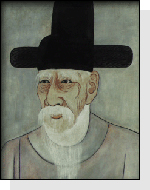- Park In- hwan (1926~1956)
- Park Su- geun (1914~1965)
- Kim Yu- jeong (1908~1937)
- Lee Hyo- seok (pen name Gasan) (1907~1942)
- Kim Dong- myeong (Choheo) (1901~1968)
- Han Yong- un (Buddhist name Manhae) (1897~1944)
- Namgung Eok (pen name Hanseo) (1863~1939)
- Yun Hui- sun (1860~1935)
- Yu In- seok (pen name Uiam) (1842~1915)
- Kim Byeong- yeon (pen name Nango) (1807~1863)
- Nam Gu- man (pen name Yakcheon) (1629~1711)
- Heo Mok (pen name Misu) (1595~1682)
- Heo Gyun (pen name Gyosan) (1569~1618)
- Heo Cho- hui (pen name Nanseolheon) (1563~1589)
- Sinsaimdang (1504~1551)
- Kim Si- seup (pen name Maewoldang) (1434~1493)
- Won Cheon- seok (pen name Ungok) (1330~ ?)
- Lee Seung- hyu (pen name Dongangeosa) (1224~1300)
Heo Mok (pen name Misu) (1595~1682)

A civil servant during the late Joseon dynasty, he earned high reputation as an exemplary official while he served as Busa (governor) of Samcheok.
He hailed from Yeoncheon, Gyeonggi Province. His pen name was Misu, and his original ancestor originated from Yangcheon.
In 1624 (the second year of King Injo), when he was living in Ucheon, Gwangju,
he immersed himself in reading and calligraphy, and accomplished a unique calligraphic style in writing Chinese characters.
This has earned him the reputation of No. 1 calligrapher in the Orient. He never applied for a civil service examination,
but instead led a humble life.
However, at 56, he was recommended to serve as Chambong (low-ranking official) for the first time, and he afterwards ascended to the governorship at 81. This marks an unprecedented case that a person did not pass Gwageo (high-class civil service examination) but ascended to such a high-ranking position as a governor.
In 1657 and 1659, (8th and 10th year of King Hyojong), when he became Gongjo Jipyeong and Jangryeong (supervisory officials), respectively, he appealed to the King to reconsider seriously Song Siyeol´s policy on the conquest of northern areas. In 1660 (the first year of King Hyeonjong), when he argued with Song Siyeol over King Hyojong´s mourning formalities related to his mother´s death (sparking a stir in the political world), King Hyeonjong relegated him to Busa (governor) of Samcheok. While he served as Busa (governor) of Samcheok for two years beginning in October 1660, he enactedHyangyak (regulations and rules for villagers) and strove to enlighten the dwellers in accordance with it. He furthermore compiled the Cheokjuji book. With Samcheok located in proximity to the East Sea, people suffered heavily from the tidewater. He erected a stone aimed at repelling the tidewater and then calmed the disrupted dwellers. He based this on an old episode from the Chinese Tang dynasty. This stone is called “Cheokjudonghaebi”, with its inscription made in unique writing style
However, at 56, he was recommended to serve as Chambong (low-ranking official) for the first time, and he afterwards ascended to the governorship at 81. This marks an unprecedented case that a person did not pass Gwageo (high-class civil service examination) but ascended to such a high-ranking position as a governor.
In 1657 and 1659, (8th and 10th year of King Hyojong), when he became Gongjo Jipyeong and Jangryeong (supervisory officials), respectively, he appealed to the King to reconsider seriously Song Siyeol´s policy on the conquest of northern areas. In 1660 (the first year of King Hyeonjong), when he argued with Song Siyeol over King Hyojong´s mourning formalities related to his mother´s death (sparking a stir in the political world), King Hyeonjong relegated him to Busa (governor) of Samcheok. While he served as Busa (governor) of Samcheok for two years beginning in October 1660, he enactedHyangyak (regulations and rules for villagers) and strove to enlighten the dwellers in accordance with it. He furthermore compiled the Cheokjuji book. With Samcheok located in proximity to the East Sea, people suffered heavily from the tidewater. He erected a stone aimed at repelling the tidewater and then calmed the disrupted dwellers. He based this on an old episode from the Chinese Tang dynasty. This stone is called “Cheokjudonghaebi”, with its inscription made in unique writing style
최근 업데이트 2023-01-10


